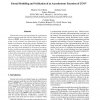Free Online Productivity Tools
i2Speak
i2Symbol
i2OCR
iTex2Img
iWeb2Print
iWeb2Shot
i2Type
iPdf2Split
iPdf2Merge
i2Bopomofo
i2Arabic
i2Style
i2Image
i2PDF
iLatex2Rtf
Sci2ools
ECOWS
2006
Springer
2006
Springer
Formal Modelling and Verification of an Asynchronous Extension of SOAP
Current web services are largely based on a synchronous request-response model that uses the Simple Object Access Protocol SOAP. Next-generation telecommunication networks, on the contrary, are characterised by the need to handle asynchronous interactions among distributed service components, e.g., to deal with long-running computations and with events produced by the network resources. As these worlds are more and more converging into a single application context, several solutions have been proposed to deal with asynchronous events in the context of web services. In this paper we formalise and verify one such approach, viz., an original asynchronous extension of SOAP, and draw some conclusions. The formal model is specified as a set of communicating state machines. The semantics of the model is seen as a doubly-labelled transition system, and its behavioural properties are expressed in the actionand state-based temporal logic
Asynchronous | ECOWS 2006 | Internet Technology | Simple Object Access Protocol | Synchronous Request-response Model |
| Added | 22 Aug 2010 |
| Updated | 22 Aug 2010 |
| Type | Conference |
| Year | 2006 |
| Where | ECOWS |
| Authors | Maurice H. ter Beek, Stefania Gnesi, Franco Mazzanti, Corrado Moiso |
Comments (0)

